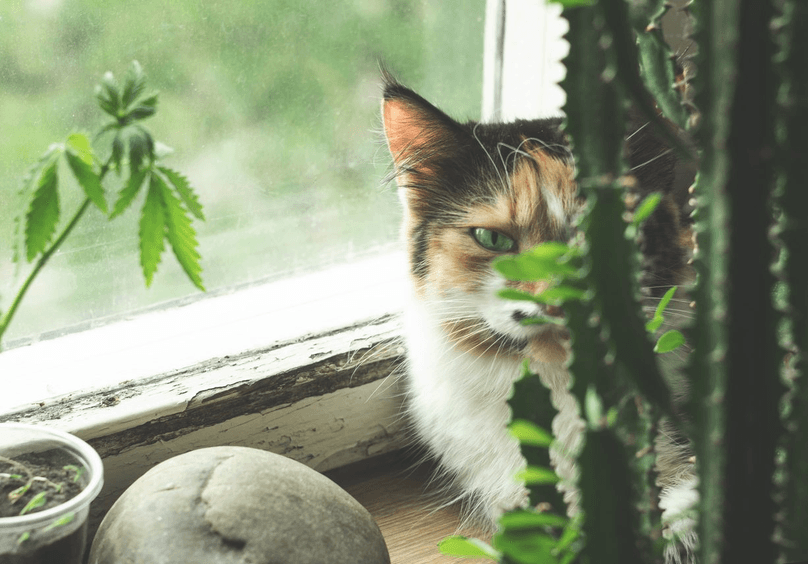
Reviewed by: Lizz Caputo
Cat aficionados, we’re all on the same mission: to carve out a sanctuary that’s both happy and healthy for our feline friends. But, here’s a curveball—our human-safe havens aren’t always a paradise for pets. Enter cannabis. While the herb is enjoyed by millions across the globe, it’s all the more relevant to dial into pet safety in our ever-greening landscape.
Veterinarians are ringing the alarm louder than ever with a spike in emergency visits linked to cannabis mishaps. Time to brush up on our weed IQ and arm ourselves with strategies to shield our cats from unintended dangers.
Cannabis 101
Long before its buzz, cannabis was a jack-of-all-trades. It’s been cultivated since about 500 CE for various purposes, from textiles to medicine. It’s a complex herb, rich in cannabinoids like Tetrahydrocannabinol (THC), which plays Pied Piper with our brain’s receptors. Sadly, in this case a chill vibe for humans can be a red flag for cats.
Let’s take a close look at why weed and whiskers don’t mix.
Can Cats Get High?
While cats can indeed experience effects from substances like THC, it’s a far cry from the human experience of ‘getting high.’ For our feline friends, these encounters are less about cosmic revelations and more about disorienting, and often distressing, reactions.
Simply put, while cats might react to THC exposure, it’s not a recreational high but a potentially hazardous situation. This underscores the importance of keeping our green indulgences out of paw’s reach, ensuring our pets stay safe and their world remains comfortably mundane.
Why Cats and Cannabis Clash
Cats and cannabis oil? Not a good mix. Cats’ systems aren’t designed to break down certain compounds, leading to a dangerous buildup. Michigan State University’s College of Veterinary Medicine highlights symptoms of cannabis toxicity in cats that range from a sedated state to severe health threats like seizures or worse.
If you indulge in a “gardening session” once in a while, keep an eye out for these signs of toxicity:
- Excessive sleepiness or excitation
- Drooling
- Dilated pupils
- Low blood pressure
- Vomiting
In more severe cases, your pet may experience heart arrhythmias such as bradycardia (a slow rhythm), seizures, or even death.
Treatment for Cannabis Overdose in Pets
Memorize these steps in case of a Cannabis emergency. If you ever suspect your whiskered wanderer has dipped into something they shouldn’t, get your vet on speed dial – stat! Details matter—what they’ve ingested, how much, and its potency. Your vet isn’t there to judge, but rather needs all relevant information in order to provide the best cat care.
While not all cannabis encounters are lethal, cats are small and sensitive to toxic exposure, soquick action is key. The ASPCA’s animal poison control center is also a toll-free call away at (888) 426-4435 for immediate advice.
Most cannabis exposures in cats do not require hospitalization, however, your vet may choose to keep your animal overnight for observation or further treatment.
Preventing Cannabis Curiosity and Toxic Exposure in Cats
So how does cannabis exposure occur and how can we prevent our curious kitties from partaking?
The rise of edibles has made it trickier to keep pets out of pot’s reach. To a cat, that gummy or chocolate could just be another treat. That’s likely why the majority of toxic exposures reported to vets can be traced to edible forms of the drug. THC and other cannabinoids in natural cannabis flower must be heated to induce their effects, making it difficult for a catnip mixup to result in a toxic overdose.
When it comes to keeping your frisky feline safe, here’s our advice:
- Label any cannabis products that may be confused with catnip
- Don’t let curious cats nibble on buds or other parts of the cannabis plant
- Keep any homemade cannabis edibles (“pot brownies”) away from pets
- Keep cannabis edibles, capsules, or other consumables stored in a place that’s safe from cat claws
Ultimately, the #1 pro-tip is to keep your stash out of paw’s reach and catnip confusion at bay via responsible storage.
The Catnip Connection
No worries, catnip’s still cool. This feline favorite, from the mint family, is all fun (minus THC and other compounds found in cannabis) offering a safe buzz without the baggage.
As pet parents, our role is to navigate our pets through the highs and lows of life, cannabis included. Let’s keep our spaces green and our pets serene by staying informed and proactive. With a bit of vigilance, smart storage solutions, and your vet’s phone number at the ready, we can promote a world where cats and cannabis can coexist, just not in the same snack drawer.